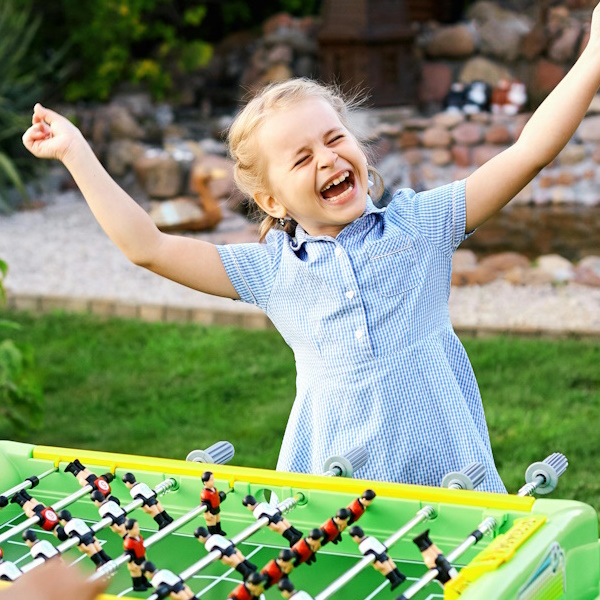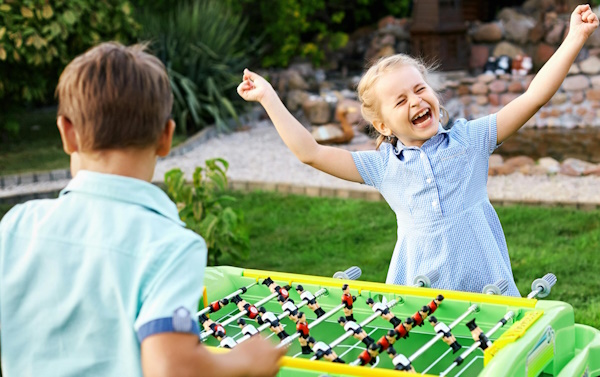Fun Physical Activities for Kids: Balance Screen Time with Active Play
Getting your kids moving isn't just about burning energy—it's about setting the foundation for a healthy lifestyle. With screens and digital entertainment capturing so much of their attention, finding fun and engaging physical activities for kids has never been more crucial. It's all about striking the right balance and making exercise feel like play, not a chore.
From classic games that never grow old to innovative ways to get active, there's a whole world of options out there. Whether you're looking to boost their fitness levels, enhance their coordination, or simply inject more fun into their daily routine, we've got you covered. Let's dive into the myriad of ways you can turn activity time into the highlight of their day.
Why Physical Activities are Important for Kids
In today's digital age, it's easy for kids to get caught in a sedentary lifestyle. You might notice your child spending hours in front of screens, missing out on the benefits of physical activity. The importance of getting kids moving cannot be overstated. When kids engage in physical activities, they're not just burning off energy. They're laying the foundation for a healthy lifestyle.
Physical activities boost not only physical health but cognitive development as well. Engaging in sports or outdoor games helps improve coordination, flexibility, and strength. It also enhances children's problem-solving abilities and teamwork skills. Regular exercise has been shown to improve mood and sleep quality, making it a crucial component of every child's daily routine.
Here's a quick glimpse into the benefits of physical activities for kids:
- Improved physical health: Regular exercise helps control weight, builds healthy bones, and increases muscular strength.
- Enhanced mental well-being: Physical activities can decrease symptoms of depression and anxiety.
- Better academic performance: Active kids often show greater attention and faster cognitive processing speed.
Consider the following statistics which underline the importance of physical activities:
| Age Group | Recommended Daily Activity Time |
|---|---|
| 3-5 years | At least 60 minutes |
| 6-17 years | 60 minutes or more |
These recommendations aim to ensure that kids from an early age develop habits that will stick with them throughout their lives. Introducing a variety of activities can make exercise feel less like a chore and more like fun, encouraging them to stay active regularly.
By recognizing the importance of physical activities, you're taking a vital step towards ensuring your child leads a balanced, healthy life. Offering opportunities for exercise through sports, dance, or simple playground activities can make a significant difference in their overall well-being.
Finding the Right Balance between Screen Time and Physical Activity
In today's digital world, balancing screen time and physical activity is crucial for your child's development. With gadgets becoming an inseparable part of daily life, it's essential to find a healthy equilibrium that promotes both educational enrichment and physical well-being.
First, set clear limits on screen time. The American Academy of Pediatrics suggests no more than one to two hours of quality screen time per day for children over 2 years old. For physical activity, children aged 6 to 17 should aim for at least 60 minutes of moderate to vigorous physical activity daily. Balancing these activities can prevent the adverse effects of prolonged screen time, such as obesity, sleeping disorders, and social isolation.
Incorporating physical activity into family routines can make a significant difference. Here are a few tips:
- Schedule regular walks or bike rides as a family.
- Encourage participation in sports or dance classes.
- Use screen time as a reward for being active.
Technology isn't the enemy, however. Educational apps and video games that encourage physical movement or outdoor exploration can also contribute positively to your child's physical activity. The key is choosing screen activities that are engaging and promote learning or physical movement, rather than passive consumption.
Remember, every child is unique, and what works for one may not work for another. Monitor and adjust your approach based on your child's needs and interests. By promoting a balanced and active lifestyle, you're not only enhancing your child's physical and mental health but also setting the foundation for healthy habits that can last a lifetime.
Classic Games that Never Grow Old
In the fast-paced digital landscape, it's easy to overlook the simple joys that classic games bring to our children's lives. These activities are not only timeless but crucial in fostering physical fitness, creativity, and social skills. Let's dive into a few games that have stood the test of time.
Hide and Seek has been a favorite for generations. It teaches kids the value of strategy and the thrill of the chase. Whether it's indoors on a rainy day or sprawling across the backyard, the laughter and excitement that this game brings are unmatched.
Tag offers endless variations and requires nothing but open space and a group of friends. It's incredible for building agility and stamina. Plus, the roles of chaser and runner keep changing, ensuring everyone gets a turn to sprint their heart out.
Hopscotch combines skill, balance, and fun in a simple sidewalk game. All you need is chalk and a small stone to throw. Players hop through numbered spaces, retrieving the stone without losing their balance. It's a wonderful way to develop coordination and control.
Skipping Rope can be both a solo and group activity. It's phenomenal for timing, rhythm, and cardiovascular health. Jump rope challenges and rhymes have been passed down through generations, making it a perpetually engaging game.
Integrating these classic games into your child's routine encourages a break from screens and promotes physical well-being. Each game is adaptable, meaning you can adjust them to suit any age or skill level. They're not just exercises but opportunities for your kids to learn, grow, and most importantly, have fun.
Remember, it's about striking that perfect balance between digital and physical play. Involving yourself in these activities can also strengthen bonds and create lasting memories with your children. So, why not dust off those old favorites and reintroduce them into your family's playtime?
Innovative Ways to Keep Kids Active
In today's fast-paced world, keeping kids engaged in physical activities requires creativity and innovation. You'll find that blending technology with traditional outdoor games can lead to exciting new options that will captivate their interest. Geocaching, a real-world outdoor treasure hunting game using GPS-enabled devices, offers an adventurous way to explore the outdoors. It combines technology with the thrill of discovery and can be an engaging activity for the whole family.
Interactive Fitness Apps have also revolutionized how children view exercise. Apps like Zombies, Run! for older kids turn physical activity into a thrilling survival game. For younger children, apps that simulate sports or dance routines can make exercising feel like playtime instead of a chore.
Don't overlook the potential of DIY Obstacle Courses. Using everyday items, you can create a challenging and fun course in your backyard. This not only promotes physical fitness but also encourages problem-solving and creativity. You can tailor the course to be as simple or complex as you like, ensuring it's suitable for children of all ages.
- Hiking
- Bike rides
- Nature scavenger hunts
Encouraging kids to connect with nature not only fosters a love for the environment but also promotes physical well-being. Hiking on local trails, going on family bike rides, or organizing nature scavenger hunts are excellent ways to combine physical activity with environmental education.
By introducing these innovative methods, you're not just helping your kids stay active; you're also ensuring they develop a balanced and healthy lifestyle. Remember, variety is key. Mixing technology with outdoor adventures can provide a comprehensive activity regime that keeps the body moving and the brain stimulated.
Boosting Fitness Levels and Enhancing Coordination
In today's sedentary lifestyle, where screens often captivate kids for hours, it's crucial to keep them moving to boost their fitness levels and enhance coordination. Engaging in various physical activities can significantly contribute to a child's physical well-being, ensuring they grow up healthy and strong.
Structured sports such as soccer, basketball, and gymnastics not only encourage teamwork and discipline but also improve motor skills and hand-eye coordination. These activities challenge children in dynamic environments, making them adapt and learn new skills. Moreover, regular participation in sports sets a foundation for a lifelong habit of staying active.
For parents and guardians aiming to integrate more physical activities into their children's routines, consider incorporating fun and accessible exercises at home. Simple jump rope sessions, mini obstacle courses, or even yoga can make a substantial difference in a child's agility and overall fitness. These activities don't require much equipment and can be adjusted to fit any space, making them perfect for daily exercise routines.
It's also important to recognize that developing coordination goes hand in hand with enhancing balance. Activities like climbing, balance beam challenges, or practicing martial arts are exceptional for teaching children how to control and manage their body movements. As they learn to navigate these challenges, kids naturally improve their balance, which is essential for most physical activities and sports.
Emphasizing the importance of regular physical activity is key to raising health-conscious individuals. By integrating a variety of sports and exercises into their daily lives, children not only boost their fitness levels but also acquire crucial life skills such as teamwork, perseverance, and resilience. Encouraging them to try new activities also fosters a sense of curiosity and love for staying active, which is invaluable for their physical and mental development.
Injecting Fun into Daily Routine with Physical Activities
Making physical activity a fun part of your child’s daily routine can sometimes feel like a challenge, especially with the allure of screens and technology. However, with a little creativity and enthusiasm, you can turn exercise into an exciting adventure that your kids will eagerly anticipate.
Start with Family Dance Parties. Crank up your child's favorite tunes and dance around the living room. It’s a fantastic way to get moving, laugh together, and boost your family's mood. Plus, it doesn’t require any special equipment or skills – just a love for fun.
Incorporate Mini-Challenges throughout the day. These can be quick, spontaneous competitions like who can do the most jumping jacks during a commercial break or a race to see who can clean up their toys the fastest while mimicking animal movements. These mini-challenges not only inject fun into mundane tasks but also subtly boost physical activity levels.
Adventure Walks offer another great opportunity. Turn a regular walk into a thrilling adventure by creating a storyline or a mission – maybe you’re explorers searching for a hidden treasure, or superheroes on a mission to save the world. You can even use props or costumes for added excitement. This approach transforms walking from a simple exercise into an immersive experience that sparks imagination and movement.
Emphasizing the Joy of Movement rather than the concept of exercise can significantly change your child's perspective on physical activity. Highlight how fun it is to feel strong, fast, and agile. Share your own experiences and joys of moving your body, making it about the pleasure of the activity rather than a task to check off.
To keep physical activity exciting, Rotate Activities regularly. If you keep repeating the same games or exercises, it's easy for kids (and adults!) to lose interest. Introducing new games, sports, and challenges keeps things fresh and engaging for everyone involved. Whether it’s trying out a new trail for your adventure walks or learning a new dance, variety is key to maintaining enthusiasm.
Remember, the goal is to weave physical activity seamlessly into your everyday life, making it a natural and enjoyable part of your routine. By following these tips and letting your creativity shine, you’ll not only help your kids stay active but also create memorable moments together.
Conclusion
Embracing the joy of movement and integrating it into your family's daily life is essential. With the plethora of options available from classic games to innovative tech-driven activities, there's no shortage of ways to keep your kids active and engaged. Remember it's about finding the right balance that works for your family, keeping activities fun and varied to maintain interest. By participating alongside them, you're not only promoting a healthy lifestyle but also creating unforgettable memories. Let's make physical activity an enjoyable and indispensable part of our children's lives.







